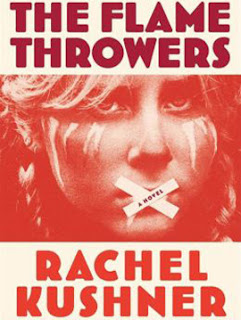It was much more expansive than most people knew, sucking in young men and women as they orbited creative, outspoken, and sometimes moneyed artists alongside seedier friends who just managed to scrape by despite being accepted. It was an odd but exhilarating time when anyone could make it.
Reno, nicknamed after her hometown in a dusty northwest corner of Nevada, is one of them. After graduating from art school, she sold her motorcycle and headed toward New York City in the hopes of becoming an artist. Later she would own another one; a Valera motorcycle gifted to her by a boyfriend.
The Flamethrowers is a deceptively delicious and directionless misadventure.
The story and stories interlaced within The Flamethrowers is a journey of a coming-of-age heroine who cuts her teeth on art, men, motorcycles, and revolutions. Some of the stories are her own and others are shared by the people she meets. They range from the mundane to the miraculous and the ordinary to avant-garde. It's a mixed bag.
The trick of it is, much like in life, that the stories that Reno collects are not told because they are true or false but rather because they make great anecdotes. Everyone has these little wisdoms that are supposed to teach us something about life, even if they really don't. Nobody gets it right anyway.
 And yet, there is something at the root of the well-written novel. It's largely about the duality of transformation. Change can be purifying but also destructive. And you never really know which it is until it happens. Even then, it's often about how you want to look at whatever it is that has occurred.
And yet, there is something at the root of the well-written novel. It's largely about the duality of transformation. Change can be purifying but also destructive. And you never really know which it is until it happens. Even then, it's often about how you want to look at whatever it is that has occurred.The undercoat of this idea plays out in The Flamethrowers as both the United States and Italy were undergoing different but related transformations. Nobody could tell whether they would be good or bad. And depending on where you stand on a historical timeline, they could be either, both or neither.
In New York City, specifically, the industrial era of America was ending. Soho was becoming an artist community and Lower Manhattan a financial district. As the factories disappeared, what artists did as art was equal to anything they might produce as art. Warhol himself was asking what is art anyway?
Italy was in the midst of a transformation too, with widespread radicalism that often ended in violent protests. People were killed and it wasn't always clear whether they accomplished anything or simply added to their own uncertainty. Author Rachel Kushner makes it seem much more explosive and even romantic, but its transformation spanned several decades, starting in the 60s. Some people say Italy never recovered.
The heroine who attempts to keep the threads intact.
Attempting to tie it all together is the protagonist Reno and her older boyfriend Sandro Valera's family. Although Valera is mostly estranged from his family, it still represents the rigidity of the old guard. His family made its fortune on rubber and motorcycles, exploiting Brazilians in the background and earning its fortune during the war. He might be an artist, but he is also sure-footed and certain.
Reno, on the other hand, walks through life with her eyes wide open but her head in the clouds. She does so enough that her entire life feels accidental. While her art ambitions never really take off, her velocity lands her in the right places at the right times. She climbs the social circle of an artistic fringe, sets a motorcycle land speed record, and plants herself firmly in an Italian revolt.
A few more words about author Rachel Kushner.
There isn't any question that Kushner has mastered the craft, creating intensely measured and vividly metered prose. But there is a price to be paid for the beauty of it. Reno often sounds too intellectual at times, reinforcing the notion that while the protagonist's actions belong to a free spirit, her thoughts do not. Kushner reigns in her character's thinking too tightly.
While this doesn't kill the coolness that Kushner has turned in as her second novel, it does explain some of the mixed reactions. Her own passions on contemporary art and motorcycles make the novel absorbing and rambling enough that Reno might have been better off named Berkeley, which is where Kushner earned her degree before studying at Columbia University. She currently lives in Los Angeles.
The Flamethrowers By Rachel Kushner Burns 7.1 On The Liquid Hip Richter Scale.
Given the irresistible imagery of a woman riding a motorcycle across northern Nevada in the 1970s and the success of her debut, Telex From Cuba, Kushner's second novel is probably asked to accomplish more than it ever could. It's packed with slices of subversion and clips of a counterculture era that will win over many readers (as will her writing).
But it will rightly frustrate some too, making them wait in the cold after all those pages of cool aloofness. The Flamethrowers: A Novel is available from Amazon. You can also download the book for iBooks or look for the novel at Barnes & Noble. The audiobook is perfectly narrated by Christina Traister, who breathes additional life into the would-be artist.
![Liquid [Hip]](https://blogger.googleusercontent.com/img/b/R29vZ2xl/AVvXsEjAFBQPqS7J0-rrttNoRYSsuwIePPZf4Nq6sqDioK1zzVQXJIQXKzq_NVNI4n6h3inuRQFBKOcJeZeSufkdHHIOxbSWyBjTjTxgKEQGyPzdwvkEEeECh4bI5YEGk4RWGUINSd7vulPQsCA/s1600-r/liquidhip.jpg)

